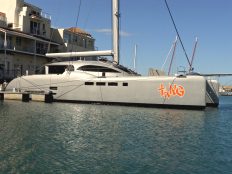
The carbon-fiber Tang launched late September. When under sail, the propellers in the water will turn the motor-generators to charge the batteries.
A hybrid power train in the world’s largest plug-in, hybrid-electric sailboat – a 60-ft Tag Yachts catamaran, will let it run on wind-generated electricity stored in lithium-ion batteries. Christened Tang at her September 21 launching, the carbon-fiber cat is undergoing tests at Tag facilities in St. Francis Bay, South Africa. She’ll set sail later this year to her owner in Florida and will appear at the Miami sailboat show in February.
“This is a transformational combination of technologies,” says Dave Tether, CEO of Electric Marine Propulsion (EMP). “Our E Motion hybrid system converts wind and solar energy into a practical power source for boat motors and auxiliaries. And, International Battery’s lithium cells provide the lightweight, high-capacity storage that really lets us take advantage of it.”
The main renewable energy input to the large-format battery pack is electricity generated by wind power as the boat’s propellers spin in the wake, when under sail. The propellers turn the 18-kW propulsion motors, which become generators, and send electricity back to the batteries.
“The initial thrust and response when engaging forward is vastly better than anything experienced with standard diesel propulsion,” says Tim van der Steene, managing director of Tag Yachts. “It’s quiet, and the power is there instantly. It goes hand-in-hand with sailing, which is about moving in harmony with nature, quietly, without polluting the environment.”

The schematic shows the general electrical layout for the 60-ft. catamaran. It’s a product of Electric Marine Propulsion.
When there’s not enough wind, twin 22-kilowatt diesel generators kick in for recharging, together or individually as needed. The generators, 144-volt dc units, recharge the batteries directly without the normal energy loss incurred through a charger.
The batteries also can be charged with a 144-volt charger that plugs into shore power. The charger handles a wide range of voltages and frequencies, a big advantage in out-of-the way ports with erratic electricity supplies.
“Using our large-format lithium prismatic cells as building blocks provides a battery with a high energy density and that means smaller footprints and lower weight,” says International Battery’s CEO Ake Almgren. “In addition, because the battery is made with an environmentally friendly, water-based manufacturing process, our batteries are right at home storing clean, renewable energy for this hybrid vessel and others to follow.”
Tang’s hybrid system includes twin E motion 18-kilowatt permanent-magnet motors and International Battery’s lithium cells configured into a 144-volt battery pack. The pack’s total energy capacity is a hefty 46 kilowatt-hours. That’s more than twice the usable capacity of an 8D battery pack – the largest conventional size carried with the E motion system. Yet the lithium pack weighs roughly 40% less.
This extra energy capacity lets the sailing yacht offer more amenities to passengers including a 37-in. flat screen TV, Bose entertainment system, LED lighting, café-size espresso machine, two refrigerator-freezers, dishwasher, microwave, conventional oven, gas or electrical burner top, washer-dryer, air-conditioning, and a water maker.
To keep the battery cells working at best levels, International Battery’s battery management system (BMS) actively balances the battery cells during charge and discharge. The BMS compares each individual cell and diverts current to or from the cells to bring all cells to an equal level.

International Battery, Allentown, Penn., produces lithium cells into several configurations. The battery pack for the Tang has a capacity for a respectable 46 kWh.
Filed Under: Energy storage, News





